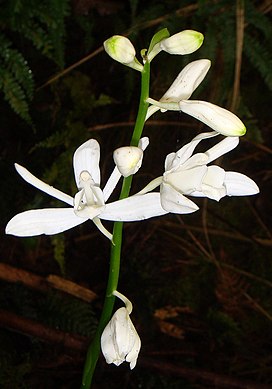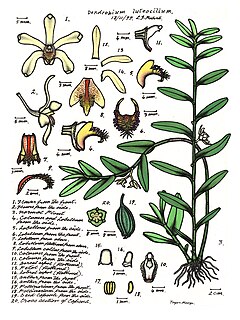
Dendrobium wassellii, commonly known as the furrowed pencil orchid, is a species of orchid endemic to a small area on Cape York Peninsula. It is an epiphytic or lithophytic orchid with branched stems, cylindrical, furrowed leaves and flowering stems with up to sixty crowded white flowers with a yellow labellum.

Dendrobium antennatum, commonly known as the green antelope orchid, is an epiphytic orchid in the family Orchidaceae. It has cylindrical pseudobulbs with up to twelve leaves near their tips and up to fifteen white flowers with green petals and a white labellum with purple stripes. It grows in New Guinea and in tropical North Queensland where it is rare.

Dendrobium discolor, commonly known as antler orchids, are epiphytic or lithophytic orchids in the family Orchidaceae. They have cylindrical pseudobulbs, each with between ten and thirty five leathery leaves, and flowering stems with up to forty mostly brownish or greenish flowers with wavy and twisted sepals and petals. Antler orchids occur in northern Australia, New Guinea and Indonesia and there are several subspecies and varieties.

Dendrobium johannis, commonly known as the chocolate tea tree orchid, is a species of epiphytic or lithophytic orchid native to Australia and New Guinea. It has spindle-shaped pseudobulbs, between five and ten dark green leaves with purplish markings and flowering stems with up to fifteen chocolate brown flowers with a yellow labellum.

Dendrobium moorei, commonly known as the drooping cane orchid, is a species of epiphytic or lithophytic orchid in the family Orchidaceae and is endemic to Lord Howe Island. It has cylindrical pseudobulbs, leathery, dark green leaves and between two and fifteen small, white drooping flowers that do not open widely.
Dendrobium brevicaudum, commonly known as the Mount Finnigan pencil orchid, is an epiphytic or lithophytic orchid in the family Orchidaceae and is endemic to Queensland. It has hanging stems, cylindrical leaves and groups of about six yellowish or orange-brown flowers with red streaks and a white labellum. It is only known from two mountainous areas north of Cairns.

Phaius amboinensis, commonly known as Arnhem Land swamp orchid, is a plant in the orchid family and is native to areas from Malesia through to New Guinea, Australia and islands in the Pacific Ocean. It is an evergreen, terrestrial herb with up to eight pleated leaves and up to twenty, relatively large white flowers with a yellow labellum. It grows in wet, shady forests.
Tainia trinervis, commonly known as the ribbon orchid, is an evergreen, terrestrial plant with crowded pseudobulbs, each with a single smooth, shiny leaf and up to fourteen greenish to yellowish flowers with red or purplish stripes in the middle. It is found in tropical Southeast Asia, New Guinea and northern Australia.

Dendrobium adae, commonly known as the slender cane orchid, is an epiphytic, sometimes lithophytic orchid in the family Orchidaceae. It has cylindrical pseudobulbs, up to four dark green leaves and up to six white or greenish to apricot-coloured flowers. It grows in tropical North Queensland, Australia.

Dendrobium baileyi, commonly known as the blotched gemini orchid, is an epiphytic or lithophytic orchid in the family Orchidaceae and has arching stems and flowering stems with one or two spidery, yellow flowers with dark purple spots emerging from leaf axis. It grows in tropical North Queensland, New Guinea and the Solomon Islands.

Dendrobium canaliculatum, commonly known as the brown tea tree orchid or thin tea tree orchid, is an epiphytic or lithophytic orchid in the family Orchidaceae. It has cone-shaped or onion-shaped pseudobulbs, up to six deeply channelled, dark green leaves and up to thirty star-shaped, light brown to caramel-coloured white or greenish to apricot-coloured flowers with darker tips. It grows in tropical North Queensland and New Guinea.

Dendrobium fleckeri, commonly known as the apricot cane orchid, is a species of epiphytic or lithophytic orchid endemic to far north Queensland, Australia. It has cylindrical pseudobulbs with two or three dark green leaves and up to four apricot-coloured or yellowish green flowers with tangled white hairs on the edge of the labellum.

Dendrobium pruinosum, commonly known as the honey orchid, is an epiphytic or lithophytic orchid in the family Orchidaceae and has flattened, yellowish stems and pairs of cream coloured, dull yellow or greenish flowers. It grows in tropical North Queensland and New Guinea.

Dendrobium mirbelianum, commonly known as the dark-stemmed antler orchid or mangrove orchid, is an epiphytic or lithophytic orchid in the family Orchidaceae. It has cylindrical, dark-coloured pseudobulbs with leathery, dark green leaves and up to twelve pale to dark brown flowers with a yellow labellum with dark red veins. This antler orchid occurs in northern Australia, New Guinea and Indonesia.

Dendrobium nindii, commonly known as the blue antler orchid, is an epiphytic or lithophytic orchid in the family Orchidaceae. It has erect, cylindrical, leafy pseudobulbs with leathery, dark green leaves and up to twenty mauve or violet flowers with darker veins on the labellum. This antler orchid occurs in tropical North Queensland and New Guinea.
Dendrobium rigidum, commonly known as the smooth tongue orchid or smooth tick orchid, is a species of orchid native to tropical North Queensland and to New Guinea. It is an epiphytic or lithophytic orchid with wiry, hanging stems, fleshy, dark green leaves and flowering stems with between two and seven crowded, cream-coloured, star-shaped flowers often with pink or red on the back. It grows on trees, shrubs and rocks in a paperbark swamps and rainforest.

Dendrobium tozerense, commonly known as the white gemini orchid, is an epiphytic or lithophytic orchid in the family Orchidaceae. It has thin, wiry stems, stiff leaves and pairs of star-shaped, white flowers. It grows in rainforest in tropical North Queensland, Australia.
Dendrobium epiphyticum, commonly known as the Illawarra rock orchid, is a species of epiphytic or lithophytic orchid that is endemic to New South Wales. It has tapered or cylindrical pseudobulbs, up to five thick, leathery leaves and up to fifty cream-coloured or pale yellow flowers with reddish purple markings on the labellum.
Dendrobium neospectabile, commonly known as the Eungella king orchid, is a species of epiphytic or lithophytic orchid that is endemic to tropical North Queensland. It has cylindrical, yellowish green pseudobulbs, up to three thick, leathery leaves and up to two hundred and fifty crowded cream-coloured to pale yellow flowers with reddish purple streaks on the labellum.
Dendrobium deuteroeburneum, commonly known as the rainforest feather orchid, is a species of epiphytic or lithophytic orchid that is endemic to eastern Australia. Its pseudobulbs are cylindrical, pressed against the host tree or rock and have one or two leathery, dark green leaves and up to seven pale greenish cream-coloured flowers with purple markings on the labellum.













